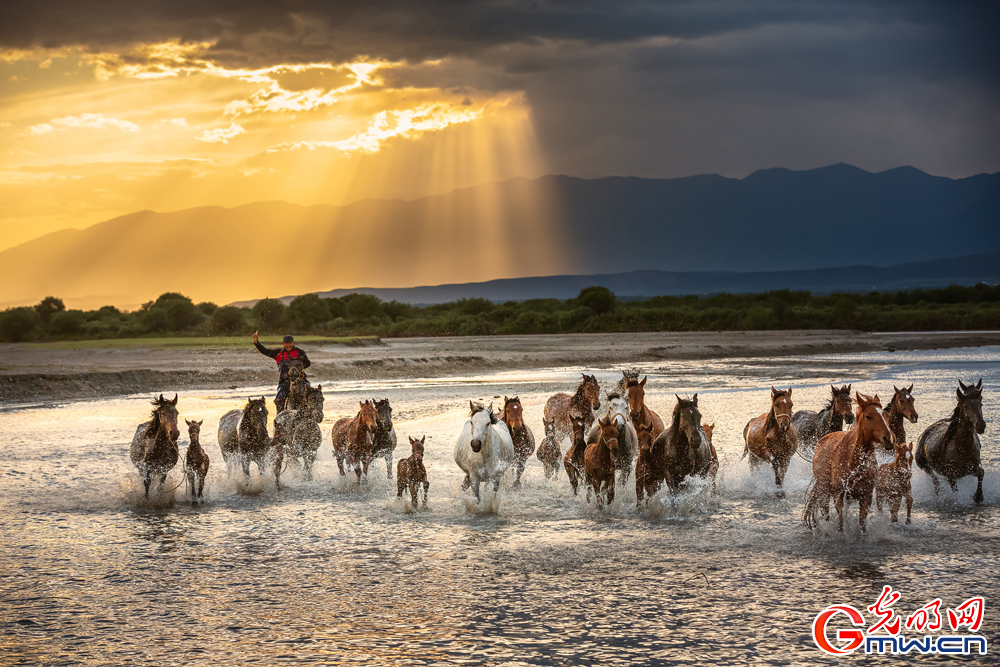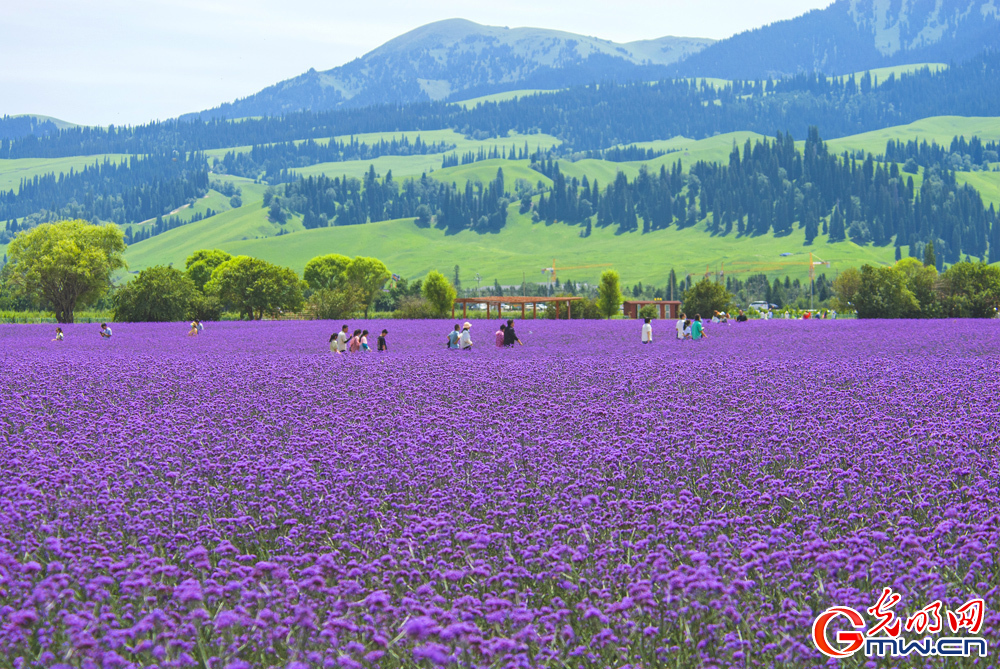IV
The beauty of Xinjiang lies in its bountiful land and diverse ethnic culture. In Xinjiang, one can easily encounter an intangible cultural heritage from a different ethnic group. Only on a land of respect, love and compassion, can culture and civilization flourish as such in Xinjiang.

“Song and horse are the two wings of the Kazakhs.” Following this ancient Kazakh proverb, we set out from Horgos, drove more than 380 kilometers along the Kungnaisi River valley under the scorching sun to the Nalati Grassland for Kazakh horses and songs.
Nalati Grassland is located in Xinyuan County, Ili Kazakh Autonomous Prefecture, in the hinterland of Tianshan Mountains and the eastern end of the Ili River Valley. The average altitude of grassland is 1800 meters, covering a total area of 1,840 square kilometers, it is known as “grassland in the air”. It’s here that one can appreciate the beauty of all four seasons at one glance: in the distance sits the snow-capped mountains, at the foot of the mountains are dense pine forests, and right before your eyes are the pasture in a river valley. No wonder people say the best grassland sits in Xinjiang’s Nalati!

On this breathtakingly beautiful grassland lives 35,000 Kazakh shepherds. Locals say each household owns “3 houses and 1 card”: an apartment in town, a yurt on the grassland, and a cottage on the grass slopes facing the sun; each household here owns hundreds of sheep, dozens of horses or cattle, which are jokingly referred to as the “mobile bank card on the grassland” because each is worth no less than 1 million yuan. Our tour guide Gosal Dotaioli’s family owns more than 300 sheep, more than 70 heads of cattle and horses. Her family hired a herder to help, so the only job left for her is to count the heads once a week.
Gosal told us that Kazakh customs and culture are unique and charming. Marriage is full of poetic romance, young men and women can find their love through the “girl chasing” in grassland dancing and party games. The first baby of the newlywed couple is presented to the grandparents to raise, and the baby would call his grandparents “dad” and “mom”. This is an ancient Kazakh tradition and an expression of gratitude to the elder generation. The “Black Walking Horse” is a folk dance that every Kazakh knows, and sheep catching and horse racing are the favorite athletic activities of the Kazakhs, their folk songs are melodious and passionate, with beautiful tunes and rugged exuberance....Today, “girl chasing”, “black walking horse”, “sheep catching” and many Kazakh folk songs have been put on the national intangible cultural heritage list.
In the east corner of the Nalati grassland, there is a professional horse racing cooperative formed by the herdsmen of Alashan village. The team has a total of more than 150 horses donated by villagers in the cooperative. On an ordinary day the team would practice traditional Kazakh horse racing and sheep catching. During tourism season, they could earn a good revenue. “Without the CPC, there wouldn’t be such happy life”, the herdsmen in the village said.
“People call me Mayra, Mayra the poet; with white teeth and a good voice, Mayra the singer”. Listening to the cheerful songs of the shepherd girl, looking at the flock of sheep like white clouds floating by, the cattle and horses at ease, and the white tents with cooking smoke, isn’t it obvious to all that this is the best protection of ethnic culture?
For thousands of years, various ethnic groups have lived with and learned from each other in Xinjiang, leaving behind a rich and colorful cultural legacy with distinctive ethnic characteristics. The exotic culture and spectacular beauty of all ethnic groups in Xinjiang are just overwhelming.
Today, there are 5,425 intangible cultural heritages and 5,632 certified inheritors in Xinjiang. It is extremely rare to see in other places of the world where intangible cultural heritages are as spectacular as in Xinjiang. And our reporters are more than overwhelmed after seeing only a few of them:

In Tekes County, Ili Prefecture, where the “Eight Diagrams City” is known across the country, we met 61-year-old Shargan Aoguai, a national intangible heritage-bearer of “Manas”. He started to learn the heroic epic of the Kirgiz people from his grandmother when he was 10 years old. Shargan has been singing “Manas” for 50 years on major festivals and gatherings with a local string instrument called “kumuz”, sometimes for three days and nights straight. “General Secretary Xi Jinping also heard my ‘Manas’ during his visit to Xinjiang not long ago, which was a great inspiration to us. I want to sing ‘Manas’ for the rest of my life, so that the heroic epic can be passed down from generation to generation,” he said.
Adlai silk is synonymous with beauty, not only loved by women of all ethnic groups in Xinjiang, but also a treasure in the eyes of the world’s top fashion designers. It is gorgeously soft and light, and is known as a “living fossil” of the Silk Road. The short video series of “I am Xiaobu, I speak for Adlai” by Hotan girl Buwei Zorizhan Metiruz has gone viral on the internet. We followed “Xiaobu” into the silk town of Gia Township, Hotan City, and saw how silk was made from cocoons, weaved into thread, tie-dyed naturally, and then weaved into silk by hand. Because of the intangible heritage skill, Hotan has gathered a large number of people who live a life as colorful as the Adlai silk.
In the village of Tawankwu Cusak in Shufan County, Kashgar Prefecture, you can hear the sound of instrumental music with strong Xinjiang ethnic styles from afar. This is the “Xinjiang Ethnic Musical Instrument Village”, a title given by China’s State Council. In an instrument workshop, we saw how craftsmen such as Rehman Abdullah, with their dexterous hands, magically transformed mulberry wood, cow horn and sheep skin into beautiful musical instruments. A 4.7-meter-long dutar tells the legend of Xinjiang’s ethnic musical instruments with its spectacular appearance. It was made by Uncle Rehman and his 18 apprentices in 45 days. Uncle Rehman learned the skill from his grandfather and father from the age of 6, and now it’s been 60 years. Today, Rehman’s biggest wish is to pass the craft to his sons and grandchildren.

In July, the ancient city of Kashgar is crowded with tourists. What were the earthen tiled and yellow-walled vernacular buildings really like? Certainly there were the staggered alleyways with colorful paintings, the dazzling boutique stores, the Shule City described by Zhang Qian in Western Han Dynasty, the Shule Governor Mansion in Tang Dynasty, and Kashgar, who governed the eight cities in southern Xinjiang in Qing Dynasty… what were they really like? The present-day Kashgar offers a window for endless imaginations.
Located in a seismically active zone and had been in a state of dilapidation, the city of Kashgar underwent a thorough renovation in 2010, and waved goodbye to the old days when “sewage was disposed by evaporation, garbage blown away by wind, and water pipes were hanging on the wall”. After renovation, the millennial city was reborn, and Kashgar has reclaimed its glory of the past. No wonder the UNESCO praised it as “a model of old city preservation and renovation in the world” and the city has become a national 5A-level scenic spot.
In Kashgar Old Town, the folklore store “Guli’s House” is an epitome of Uygur hospitality. Ladies dressed in Adlai silk costumes welcome guests with big smiles, the 80-year-old Simayi Sadiq, wearing a lined lapel robe, gave an ebullient dance on the Gate Opening Ceremony of the Ancient Kashgar City. On one side is the tinkling sound of handicraft stores forging copper pots and horse shoes, on the other side is the tranquility of earthenware artists making jars and utensils. Azeff Jiang Abdurey, a pottery shop owner, told reporters that he was already the sixth generation of earthenware craftsman, and he could earn more than 40,000 yuan a year with the craft.
If Kashgar in the day is ancient, Kashgar at night is modern. Walking along the “Kashgar Impression” street at night, bar singers perform classic songs of various ethnic groups, and the teahouses, restaurants and cultural bazaars are crowded with people, showing the unique youthful vitality of this ancient city.
Who would believe the slander that Xinjiang is a “cultural desert” when you are part of this glowing colors? A trip into Xinjiang makes one wonder who on earth is causing “cultural genocide”?
Before the arrival of white settlers, there were 5 million American Indians living on the continent. After centuries of slaughter, enslavement and deportation, by the end of the 19th century there were fewer than 240,000 of them, and it wasn’t until 1924 that they were recognized as American citizens.
American Indians were portrayed as barbaric, evil, and inferior people, and were the subject of the “Americanization” campaign. Their civilization developed over millennia was devastated. The so-called “reservations” are nothing but a fake government gesture of “cultural preservation”, under which American Indians were segregated and “kept in captivity”.
During the US invasion and occupation, 170,000 artifacts from the Iraqi Museum, one of the top 11 museums in the world identified by UNESCO, were plundered and human civilization was devastated. The US is suppressing, insulting and bullying Middle Eastern countries, seriously undermining the cultural confidence of Middle Eastern countries and people, and destroying their national pride and self-confidence.
“Culture” and “civilization” are such beautiful words, but only through equality, mutual appreciation, dialogue and tolerance can human beings transcend barriers and conflicts. Cultural coexistence must transcend the so-called “cultural superiority” so the garden of human civilization can remain colorful and diverse.













